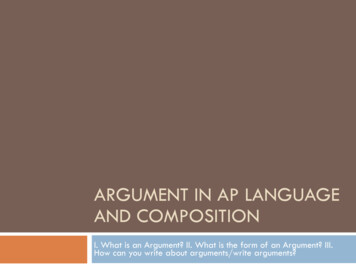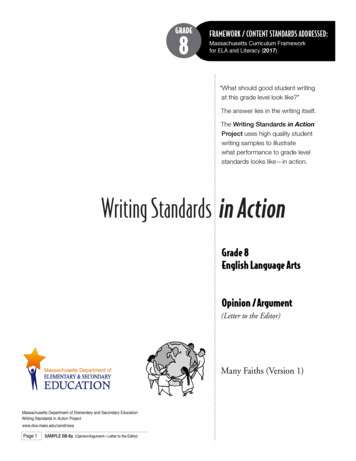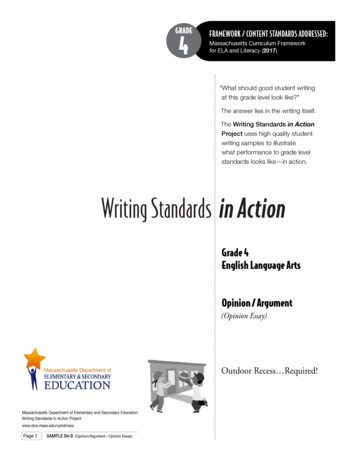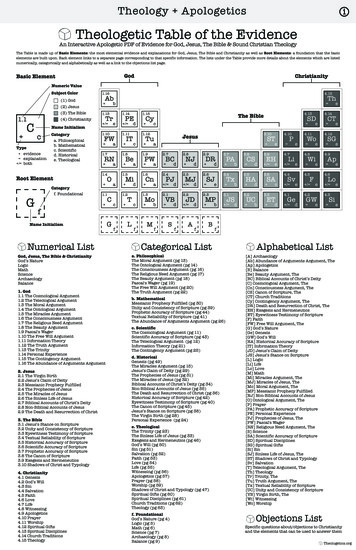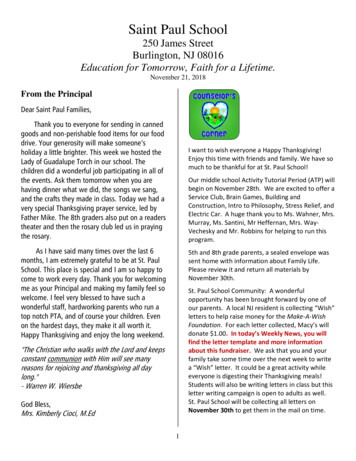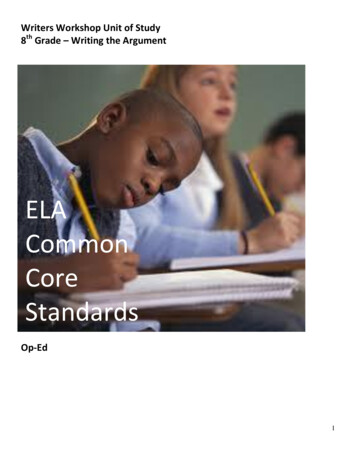
Transcription
Writers Workshop Unit of Study8th Grade – Writing the ArgumentELACommonCoreStandardsOp-Ed1
Writers Workshop Unit of Study8th Grade – Writing the ArgumentTable of ContentsPrefaceLearning Progression, Grades 6-8 . 1Learning Progression, Grades 9-12 . 3Background SectionAbstract . 5Standards . 7Overview of Sessions – Teaching Points and Unit Assessments . 9Complaint Letter Rubric . 11Resource Materials SectionResource Materials needed for each session follow the table of the Overview of that SessionSession 1 & 2 . 12Session 3. 16Session 4. 22Session 5 & 6 . 31Session 7 & 8 . 37Session 9 & 10 . 38Session 11 & 12 . 39Session 13 . 40Session 14 - 17 . 42Session 18 & 19 . 44Resources . 46Copyright 2010-2014 by the Michigan Association of Intermediate School Administrators and Oakland Schools
Writers Workshop Unit of Study8th Grade – Writing the ArgumentPrefaceThe following unit supports and aligns to the Common Core State Standards. This research-based work is the outcome ofa collective effort made by numerous secondary teachers from around the state of Michigan. Michigan Association ofIntermediate School Administrators (MAISA) initiated a statewide collaborative project, bringing together educatorsfrom around the state to create and refine a K-12 English Language Arts model curriculum. This one unit is situatedwithin a yearlong sequence of units. Depending upon the unit’s placement in the yearlong scope and sequence, it will beimportant to recognize prior skills and content this unit expects learners to have. Each unit presents a string of teachingpoints that scaffold and spiral the content and skills. The unit is structured to be student centered rather than teacherdriven. Sessions emphasize student engagement and strive to increase critical thinking and writing skills simultaneously.Writing and thinking processes are stressed and are equally important to the end writing product. Sessions are designedas a series of mini-lessons that allow time to write, practice, and conference. Through summative and formativeassessments specific to each unit, students will progress toward becoming independent thinkers and writers.Significant input and feedback was gathered both in the initial conceptualizing of the unit and later revisions. Teachersfrom around the state piloted and/or reviewed the unit, and their feedback and student artifacts helped in the revisionprocess. Special thanks go to lead unit writer Delia DeCourcy, who closely studied the CCSS, translated the standardsinto curriculum and practice, and revised with a close eye to classroom teacher feedback. Throughout the yearlongcollaborative project, teachers reviewing units are finding how students’ habits of mind have shifted from task-orientedto big-picture thinking, utilizing a critical literacy lens.Copyright 2010-2014 by the Michigan Association of Intermediate School Administrators and Oakland Schools
Middle School Argument Writing Unit Learning Progression66TextFocusGeneratingIdeas forArgumentWriting7788Make & Support a ClaimLetter of ComplaintProve Your PointProposal EssayDevelop ComplexCommentaryOp-EdMentor texts: paragraphsand essays by studentsabout year-round schoolMentor texts: samplecomplaint letters from reallife scenariosDifferentiate between factand opinion; support anopinion with evidence.Distinguish betweenfact and opinion.Understand theconcepts of claim andevidence.Understand the promptand pre-write todiscover and narrow aclaim.Craft a formal complaintletter about a real-lifesituation.Define key terms ofargument and thecomplaint-letter genre.Analyze examples ofcomplaint letters.Generate and selectviable complaint-lettertopics.Mentor texts:paragraphs and essaysby experts andjournalists about schoollunch and nutritionResearch and identifyeffective evidence tosupport a claim.Understand therelationship betweenclaim and evidence.Define and identifythe two mainevidence types.Mentor texts: video clips,magazine & newspaperarticles, essays thatoutline a problem andsuggest solutionsIdentify a problem andoutline potentialsolutions.Define key terms forthe proposal-essaygenre: problem,feasible solution,cause and effect.Analyze examples ofproposals.Generate and selectviable problems topropose solutions for.Mentor texts: paragraphsand essays by studentsabout school uniformsCraft commentary toexplain evidence thatproves a claim.Understand therelationship betweenclaim, evidence, andcommentary.Define and identify thetwo main evidencetypes.Examine howcommentary works.Creating/PlanningFind evidence fromcredible sources tosupport the claim.Find evidence throughresearch and personalreflection to support theargument.Understand theprompt.Search for evidence.Examine evidence togenerate a claim.Use search terms anddriving questions toperform research onthe problem.Select crediblesources.Sort, select, andparaphrase evidence.Understand theprompt.Search for evidence.Examine evidence togenerate a claim.DraftingRevise the original claim.Support the claim withevidence.Cite sources.Draft a problemstatement.Support the problemstatement with relevantevidence.Determine the beststructure for the letter.Revise the originalclaim.Select the mosteffective and credibleevidence to supportthe claim.Cite sources.Generatecommentary toexplain how theevidence supportsDraft a problemstatement.Explain the cause andeffect of the problem.Draft the solution.Revise the originalclaim.Select the mosteffective and credibleevidence to supportthe claim.Cite sources.Craft complexcommentary to makenew points about eachpiece of evidence.Mentor texts: op-eds fromnewspapers, magazines, andother student-friendlypublicationsTake a stand on animportant social issue andcall readers to action.Define key terms for theop-ed genre: debatableclaim, fact vs. opinion,problem, issue.Analyze examples of opeds.Understand the parts ofthe op-ed: lede, debatableclaim, counterargument,structures.Generate and select viableissues to write about.Understand how to createa logical argument usingethos, logos, pathos, andkairos.Develop acounterargument.Identify evidence tosupport the argument andcounterargument.Craft a debatable claim.Draft the argument andlogically connect theevidence to each point.Develop a strong lede.Craft thecounterargument.1Copyright 2010-2014 by the Michigan Association of Intermediate School Administrators and Oakland Schools
the claim.Revising andEditingExamine thepersuasiveness of theclaim and evidence.Reconsider theorganization of theevidence.Edit for grammar andspelling.Reflect on the processto learn from theexperience.Publish for anauthentic audience.Provide and receiveconstructive feedback.Reconsider evidence.Try differentorganizationalstrategies.Edit for grammar andspelling.Revise content andstructure.Edit for grammar(fragments and runons) and spelling.Reflect on theprocess to learnfrom theexperience.Publish for anauthentic audience.Provide and receiveconstructivefeedback.Reconsiderevidence.Try differentorganizationalstrategies.Edit for grammarand spelling.Experiment with blockand alternatingparagraph structures.Create transitionsbetween sentences toimprove flow and logic.Develop a topicsentence thatcombines claim and asummary of theevidence.Revise content andstructure.Edit for grammar(commas and dashes)and spelling.Reflect on the processto learn from theexperience.Publish for anauthentic audience.Provide and receiveconstructive feedback.Reconsider evidence.Try differentorganizational strategies.Edit for grammar andspelling.2Copyright 2010-2014 by the Michigan Association of Intermediate School Administrators and Oakland Schools
Learning Progressions for High School Argumentative Writing: Basics of Argumentationththth9 Grade10 Grade11 GradeTextFocusBecoming a CriticalReader of ArgumentAdvertisementsMedia and MarketingConnect prior knowledge about thepersuasion in these ways:1. Consumers are bombarded witharguments that may seem invisible.2. Products are marketed for their realand perceived values.Define methods and sub-genres in thefield of marketing and advertisement.Primary ResearchPower in Social SettingsEngage in reading the world as a reflectiveobserver, constructing facts and claims aboutthe ways we acquire or use power in socialsettings.Read print and digital texts, and developclaims based on reflective observation andprimary research of individuals in a publicsphere.Explore evidence after reflecting oninformation gathered from reading aboutpower. Focus and clarify multiple angles orclaims that might be taken from the evidence.Engage in conversations with others who studypower in social settings. Compare and proposeissues that matter and actions that might beconsidered.Exploring Ideas—Generating,Planning, andDraftingInquire through search and reflection toidentify the stances or positionsadvertisers use to persuade buyers.Consider persuasion for both impulseand planned consumerism.Collect and analyze evidence to developand support claims about effectivemethods used by advertisers.Compare and analyze methods used byvarious advertisements.Develop a claim based on evidencecollected through exploration ofmarketing methods, purposes, andeffectiveness of advertisements.Focus an essay by developing multipleclaims to anticipate alternate views orFilmSocial Issues in FilmReview prior knowledge about the basics ofargument.o Argument is a basic of daily life.o People encounter argumentative claims indaily living: news, reading, conversation,online blogs.o Elements: claim, evidence, counterclaims,and explanationRead film as an argumentative text to becomea critical citizen, studying and voicing opinionsabout problems that create concerns forsociety.Identify the multiple claims in a film,exploring/exposing various aspects of a socialor political issue.Identify a claim of personal interest andcollect evidence from the film to support theclaim.Study the elements of film critique to preparefor writing an argumentative film critique.Research the social issue and claim ofpersonal interest to identify the valid andinvalid evidence used in the film.Develop a claim about the effectiveness ofthe film’s portrayal and defense of a socialissue.Collect and evaluate evidence to support aclaim.Organize the key points, evidence, reasonsand explanations to develop a line ofreasoning that will convince a reader andsupport the claim.Identify a single claim that seems mostinteresting based on evidence gatheredthrough primary and secondary research.Organize the evidence to develop a line ofreasoning, planning the structure andtransitions in the essay.Write a first draft, utilizing the basic elementsof an argumentative essay: claim,counterclaim, evidence and explanation.3Copyright 2010-2014 by the Michigan Association of Intermediate School Administrators and Oakland Schools
DevelopingIdeas—Revisingand Editingcounterclaims.Identify relevant evidence, reasons andexplanations.Plan an argumentative essay based onresearch.Write a first draft using a variety ofevidence to convince a reader.Revise by outlining and annotating a firstdraft to identify the elements of anargument: claim, counterclaim, evidence(a variety), and explanation.Evaluate explanation and insert orrethink the explanation to:1. connect the explanation to theevidence.2. increase the clarity of theexplanation.3. increase the validity of the argumentRevise by rereading, and identify theacademic/topical vocabulary used in theessay. Insert or thread “insider”language used by advertisers into theessay.Edit using a checklist of common errorsthat might include: spelling, punctuation,control of syntax, sentence variety.Trace the diction to identify methods ofappeal, and trace diction to reduce andcontrol emotional appeal and develop logicalappeal and tone.Revisit the conclusion to clarify and extendthe argument, utilizing research on the issueto extend the essay into new thinking.Edit for sentence variety, consideringpunctuation present in more sophisticatedsentence structures.Revise the order and structure of the essay to:1.2.3.make connections.identify and repair diction.identify and repair evidence, consideringvalidity and bias.4. create a logical relationship betweenevidence, claims, counterclaims, andexplanation.5. increase clarity and reasoning.6. trace diction to identify methods of appeal,and trace diction to reduce and controlemotional appeal and develop logicalappeal and tone.Edit words, punctuation, sentences, correctingfor common errors.Develop sentence variety to engage a reader.4Copyright 2010-2014 by the Michigan Association of Intermediate School Administrators and Oakland Schools
Writers Workshop Unit of Study8th Grade – Writing the ArgumentAbstractThis issue-based unit asks students to think abstractly about societal issues and the concrete problems these issues generate. Afterbrainstorming about issues and their associated problems, students will select the most viable topic that interests them and performWeb research to become experts on their issue to develop a strong stance. They will collect evidence that supports their stance inorder to craft a newspaper op-ed piece that targets a specific audience and attempts to persuade them to understand the issue froma particular perspective and take action. Students will draft and rewrite to find the best structure for their op-ed after studyingmentor texts to understand the conventions of editorial/op-ed writing. They will contemplate the concept of counter argument andinclude one in their piece and refute it to strengthen their argument.To assist with the specificity of lessons, teachers may want to narrow the topic field from which students choose. This can help focusthe research lessons and sources students select from. For example, you may decide to have all students write on one issue, thoughthey can select which side of the issue to write on or a particular problem associated with the issue. This could be especiallyinteresting if there’s currently a hot issue in the community. Consider bringing in a guest speaker on the issue in addition to havingstudents perform their own research.ProcessWriting a newspaper op-ed piece, arguing one side of an issue and refuting a counterargument, in order to persuade a definedaudience to take action by:generating: a stance on a local, state, or national issue.reading: model newspaper op-eds/editorials that use logical and emotional appeals, employ a variety of evidence types,and concern local, state, and national issues.drafting: body paragraphs that define the issue and the writer’s stance, present persuasive claims and evidence to supportthe stance, explore and refute a counterargument, and provide suggestions for taking action.researching: multimedia sources to find evidence to support the writer’s stance on the issue and to identifycounterarguments.revising and editing: for a clear stance on the issue, logical and emotional appeals, effective use of evidence, refutation of acounterargument, and proper spelling and syntax.Op-Ed Unit TerminologyDebatable Claim – an opinion that is a matter of personal experience and values that must be backed up with evidence to becredible. Others can disagree with this claim.Evidence- details, facts, and reasons that support a debatable claim.Anecdotal Evidence- evidence based on personal observation and experience, often in the form of a brief story. Can comefrom the writer, friends, family, and acquaintances.Factual Evidence- data, confirmed facts, and research performed by experts. Found by the writer performing research.Issue- a point, matter, or dispute, the decision of which is of special or public importance: political issues.Problem- any question or matter involving doubt, uncertainty, or difficulty; a question proposed for solution or discussion.Lede- the opening paragraph that contains a hook to draw the reader in. Often in an op-ed, this concerns a link to current events.Counterargument – the move the writer makes to stop potential critics short by acknowledging any flaws in the main argumentand/or addressing and refuting potential objections to the main argument.Reverse Outline – an outline of the structure of an existing text that notes the focus or key claim of each paragraph and eachparagraph’s purpose in the essay.Viable- practical, feasible, usable, adaptable; able to live and grow.Viable Writing Topic- one that the writer:can make an argument forhas enough to say to engage the readerthinks the reader will care aboutcan find enough evidence to support a claim regardingknows will fulfill the expectations of the rubric5Copyright 2010-2014 by the Michigan Association of Intermediate School Administrators and Oakland Schools
Op-Ed Topic Viability1.) Issue of Scale- affects the community, state, nation or the world2.) Pressing Issue- affects people now or in the near future3.) Writer’s Investment- the writer cares about the issue, wants to take a stand, has something to sayIdea Generation (brainstorming) – a first stage process where the writer produces a list of ideas, topics, or arguments withoutcrossing any possibilities off the list. The goal is to create a “storm” of creative energy to open up thinking about the writing taskand access ideas the writer might not have realized she had. For resources on brainstorming techniques storming.htmlEthos (Credibility) – convincing the audience using the character of the author, which requires establishing the writer’s credibility,authority, and likeability. Readers must see why this writer is worth listening to and why they should respect his/her argument on asubject.Pathos (Emotional) – persuading the reader by appealing to his/her emotions on a subject.Logos (Logical) – convincing the audience of an argument using reasoning. This requires being logical and providing enoughevidence to support all points in the argument.Kairos- an element of argument in which the writer considers the time and place in which s/he is making an argument, as well as theaudience to whom the argument is being made. Kairos in an op-ed means showing how pressing an issue is and why it’s pressing forthis particular audience.Relevant (in reference to research sources) – appropriate, significant, and important to the matter at hand.Credible Source (in reference to research sources) – a reliable and accurate text created by experts in the field.6Copyright 2010-2014 by the Michigan Association of Intermediate School Administrators and Oakland Schools
StandardsCommon Core Standards: Argument Writing: The following standards apply to reading and writing in narrativetemplate tasks. Refer to the 6-12 standards for grade-appropriate specifics that fit each task and module beingdeveloped. The standards numbers and general content remain the same across all grades, but details vary.NumberCCR Anchor Standards for ReadingRI.8.1.Cite the textual evidence that most strongly supports an analysis of what the text says explicitlyas well as inferences drawn from the text.Determine a central idea of a text and analyze its development over the course of the text,RI.8.2.including its relationship to supporting ideas; provide an objective summary of the text.RI.8.4.Determine the meaning of words and phrases as they are used in a text, including figurative,connotative, and technical meanings; analyze the impact of specific word choices on meaningand tone, including analogies or allusions to other textsAnalyze in detail the structure of a specific paragraph in a text, including the role of particularRI.8.5.sentences in developing and refining a key concept.Delineate and evaluate the argument and specific claims in a text, assessing whether theRI.8.8.reasoning is sound and the evidence is relevant and sufficient; recognize when irrelevantevidence is introduced.By the end of the year, read and comprehend literary nonfiction at the high end of the grades 6–RI.8.10.8 text complexity band independently and proficiently.CCR Anchor Standards for WritingW.8.1.Write arguments to support claims with clear reasons and relevant evidence.W.8.4.Produce clear and coherent writing in which the development, organization, and style areappropriate to task, purpose, and audience. (Grade-specific expectations for writing types aredefined in standards 1–3 above.)W.8.5.With some guidance and support from peers and adults, develop and strengthen writing asneeded by planning, revising, editing, rewriting, or trying a new approach, focusing on how wellpurpose and audience have been addressed.W.8.6.Use technology, including the Internet, to produce and publish writing and present therelationships between information and ideas efficiently as well as to interact and collaboratewith others.W.8.7.Conduct short research projects to answer a question (including a self-generated question),drawing on several sources and generating additional related, focused questions that allow formultiple avenues of exploration.W.8.8.Gather relevant information from multiple print and digital sources, using search termseffectively; assess the credibility and accuracy of each source; and quote or paraphrase the dataand conclusions of others while avoiding plagiarism and following a standard format for citation.W.8.9.Draw evidence from literary or informational texts to support analysis, reflection, and research.W.8.10Write routinely over extended time frames (time for research, reflection, and revision) andshorter time frames (a single sitting or a day or two)CCR Anchor Standards for Speaking and ListeningSL.8.1Engage effectively in a range of collaborative discussions (one-on-one, in groups, and teacherled) with diverse partners on grade 8 topics, texts, and issues, building on others’ ideas andexpressing their own clearly.SL.8.2.Analyze the purpose of information presented in diverse media and formats (e.g., visually,quantitatively, orally) and evaluate the motives (e.g., social, commercial, political) behind itspresentation.SL.8.3Delineate a speaker’s argument and specific claims, evaluating the soundness of the reasoning7Copyright 2010-2014 by the Michigan Association of Intermediate School Administrators and Oakland Schools
SL.8.6L.8.1.L.8.2.L.8.3L.8.4L.8.6.and relevance and sufficiency of the evidence and identifying when irrelevant evidence isintroduced.Adapt speech to a variety of contexts and tasks, demonstrating command of formal English whenindicated or appropriate.CCR Anchor Standards for LanguageDemonstrate command of the conventions of standard English grammar and usage when writingor speaking.Demonstrate command of the conventions of standard English capitalization, punctuation, andspelling when writing.Use knowledge of language and its conventions when writing, speaking, reading, or listeningDetermine or clarify the meaning of unknown and multiple-meaning words or phrases based ongrade 8 reading and content, choosing flexibly from a range of strategies.Acquire and use accurately grade-appropriate general academic and domain-specific words andphrases; gather vocabulary knowledge when considering a word or phrase important tocomprehension or expression.8Copyright 2010-2014 by the Michigan Association of Intermediate School Administrators and Oakland Schools
Overview of Sessions: Teaching Points and Unit AssessmentsPre-Unit Assessment TaskTEACHING POINTSGenerating Ideas for Argument Writing1. When writers write and publish opinion pieces, they make debatable claims about an issue or a problem, which they back up withfacts. Opinions alone are not enough to make an argument. A writer must provide evidence to support his/her opinion and convincethe audience.2. When writers write and publish opinion pieces, they make debatable claims about an issue or a problem, which they back up withfacts. Opinions alone are not enough to make an argument. A writer must provide evidence to support his/her opinion and convincethe audience.3. Op-eds have an interesting or surprising viewpoint about an issue or problem impacting the community, nation, or world rightnow. They aim both to inform and take a clear stand on an issue, and often to spur the reader to action. Op-eds are typically 600-800words. Op-eds, short for opposite the editorial page, are distinct from editorials because they are not written by someone on thepublication’s editorial review board.4. Writers of op-eds follow certain rules, also know as conventions, when crafting their pieces. Op-eds often begin with a lede, thenprogress to a thesis that states the debatable claim, and develop the argument in ensuing paragraphs using a variety of types ofevidence. The piece wraps up with a counterargument and/or a call to action. The writer must also make clear why the issue orproblem is immediately pressing and/or relevant.5. The topic selection stage of the writing process is an especially important one because it is here where a writer commits herself toa focus for a project. So it’s important to spend ample time brainstorming and pre-writing to discover ideas and explore them. And awriter must carefully consider if a topic is viable for the given writing task. Taking these steps helps writers make a well- informeddecision when they commit to a topic, meaning there is less likelihood that they’ll run into trouble and have to start over.6. The topic selection stage of the writing process is an especially important one because it is here where a writer commits herself toa focus for a project. So it’s important to spend ample time brainstorming and pre-writing to discover ideas and explore them. And awriter must carefully consider if a topic is viable for the given writing task. Taking these steps helps writers make a well- informeddecision when they commit to a topic, meaning there is less likelihood that they’ll run into trouble and have to start over.Creating/Planning7. When people take stances on problems and issues, they tend to be quite passionate. But passion does not always make for astrong argument. Writers must balance ethos (credibility), logos (logic), and pathos (emotion) to achieve a strong argument. Writersof op-eds must especially use logical reasoning, which comes in the form of laying out a line of thinking and analyzing facts tosupport their stances.8. Writers use different types of evidence to support their arguments. The most common, especially with op-eds, are statistical,anecdotal, personal, news stories, scholars/experts, and interviews. Writers must consider the type of evidence to employ given thekind of appeal they are making at any moment in their argument. For example, arguments relying on ethos require personalevidence to lend credibility to a writer’s claims, while a point that relies on logos would need to employ statistical and expertevidence.9. Writers of op-eds or any argument essay must acknowledge and refute counterarguments to further strengthen their stance.Particularly in the op-ed mode, acknowledging and addressing the audience’s potential concerns about the writer’s claimstrengthens the argument’s logic and can convince readers who are on the fence. The counterargument(s) a writer chooses toaddress typically depend on the intended and/or anticipated audience of the publication.10. To perform research efficiently and accurately, writers must know how to ask good questions and identify key search terms.Writers must take a trial-and-effort approach with research as they find sources, determine their credibility, gain new knowledgeabout their topic, and further define the information and evidence they must gather.9Copyright 2010-2014 by the Michigan Association of Intermediate School Administrators and Oakland Schools
11. To perform research effici
8th Grade – Writing the Argument Op-Ed ELA Common Core . from around the state to create and refine a K-12 English Language Arts model curriculum. This one unit is situated within a yearlong sequence of units. Depending upon the unit’s
